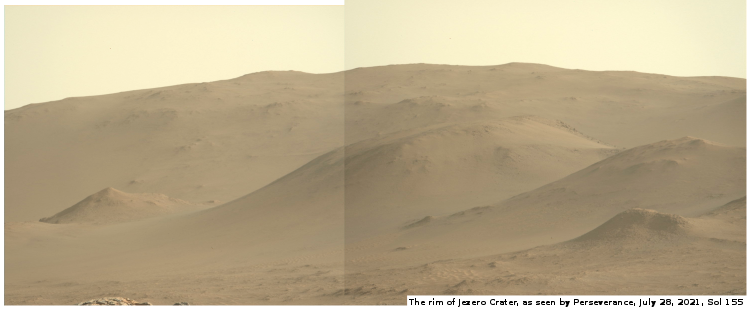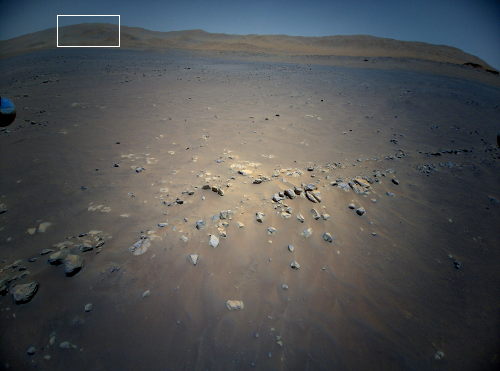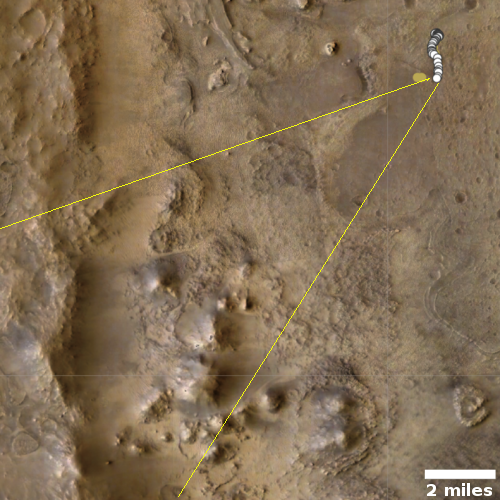The view of Jezero Crater, from both Ingenuity and Perseverance
Cool image time! Today the Perseverance science team released the 200 images that Ingeniuty took during its 10th flight on July 24, 2021.
The photo to the right was taken about 25 seconds before the helicopter landed, and looks to the southwest. In the foreground can be seen the ridge of rocks and pebbles that the scientists sent Ingeniuty to photograph. In the distance can be seen the rim of Jezero Crater, about 7.5 miles away, with some rounded hills that sit in the crater floor about 5.5 miles away.
The white box indicates the area covered by two high resolution images taken by Perseverance on July 28th that I have combined into the panorama below.

Click for high resolution version. Original images found here and here.
To the right is an overview map. The yellow lines roughly indicate what Perseverance’s panorama sees.
Unlike the distance photos by Curiosity of the foothills of Mount Sharp, which vary across a wide range of colors, this panorama of the rim of Jezero Crater suggests the geology here is far less varied. The softness of the hills also suggests a different level or manner of erosion than at Gale Crater.
The rim of Jezero is also not as high as Mount Sharp. Still, this panorama hints at the terrain that Perseverance — and hopefully Ingenuity — will see in the coming years as both work their way west to the crater rim, up onto the delta-like formation and into the gap from which that delta had flowed. The journey is not going to be boring visually, for sure.
On Christmas Eve 1968 three Americans became the first humans to visit another world. What they did to celebrate was unexpected and profound, and will be remembered throughout all human history. Genesis: the Story of Apollo 8, Robert Zimmerman's classic history of humanity's first journey to another world, tells that story, and it is now available as both an ebook and an audiobook, both with a foreword by Valerie Anders and a new introduction by Robert Zimmerman.
The print edition can be purchased at Amazon or from any other book seller. If you want an autographed copy the price is $60 for the hardback and $45 for the paperback, plus $8 shipping for each. Go here for purchasing details. The ebook is available everywhere for $5.99 (before discount) at amazon, or direct from my ebook publisher, ebookit. If you buy it from ebookit you don't support the big tech companies and the author gets a bigger cut much sooner.
The audiobook is also available at all these vendors, and is also free with a 30-day trial membership to Audible.
"Not simply about one mission, [Genesis] is also the history of America's quest for the moon... Zimmerman has done a masterful job of tying disparate events together into a solid account of one of America's greatest human triumphs."--San Antonio Express-News
Cool image time! Today the Perseverance science team released the 200 images that Ingeniuty took during its 10th flight on July 24, 2021.
The photo to the right was taken about 25 seconds before the helicopter landed, and looks to the southwest. In the foreground can be seen the ridge of rocks and pebbles that the scientists sent Ingeniuty to photograph. In the distance can be seen the rim of Jezero Crater, about 7.5 miles away, with some rounded hills that sit in the crater floor about 5.5 miles away.
The white box indicates the area covered by two high resolution images taken by Perseverance on July 28th that I have combined into the panorama below.

Click for high resolution version. Original images found here and here.
To the right is an overview map. The yellow lines roughly indicate what Perseverance’s panorama sees.
Unlike the distance photos by Curiosity of the foothills of Mount Sharp, which vary across a wide range of colors, this panorama of the rim of Jezero Crater suggests the geology here is far less varied. The softness of the hills also suggests a different level or manner of erosion than at Gale Crater.
The rim of Jezero is also not as high as Mount Sharp. Still, this panorama hints at the terrain that Perseverance — and hopefully Ingenuity — will see in the coming years as both work their way west to the crater rim, up onto the delta-like formation and into the gap from which that delta had flowed. The journey is not going to be boring visually, for sure.
On Christmas Eve 1968 three Americans became the first humans to visit another world. What they did to celebrate was unexpected and profound, and will be remembered throughout all human history. Genesis: the Story of Apollo 8, Robert Zimmerman's classic history of humanity's first journey to another world, tells that story, and it is now available as both an ebook and an audiobook, both with a foreword by Valerie Anders and a new introduction by Robert Zimmerman.
The print edition can be purchased at Amazon or from any other book seller. If you want an autographed copy the price is $60 for the hardback and $45 for the paperback, plus $8 shipping for each. Go here for purchasing details. The ebook is available everywhere for $5.99 (before discount) at amazon, or direct from my ebook publisher, ebookit. If you buy it from ebookit you don't support the big tech companies and the author gets a bigger cut much sooner.
The audiobook is also available at all these vendors, and is also free with a 30-day trial membership to Audible.
"Not simply about one mission, [Genesis] is also the history of America's quest for the moon... Zimmerman has done a masterful job of tying disparate events together into a solid account of one of America's greatest human triumphs."--San Antonio Express-News




A nit in last sentence: “The journey is not going to BE boring visually, for sure.” Cheers.
Ray Van Dune: Thank you. Fixed. One of my problems is that my fingers can no longer keep with my brain, and so to keep up they sometimes drop out words. I reread to try to catch this, but obviously miss some.
Without my readers what would I do? Thank you again.
The second picture is beautiful, and it looks as well-lit as a desert-scape here on Earth. However, this NASA page
https://www.nasa.gov/audience/foreducators/9-12/features/F_How_Far_How_Faint.html
explains that Mars gets about 44% of the light we get here. That means that the image shown should have less than half the light intensity we see. Obviously, Nasa / JPL, the camera equipment itself, or both, compensated for that source light intensity. Planets past Mars have even lower light intensity. This goes the other way, too. Mercury has much higher light intensity, compared to Earth. Mercury pictures don’t show that. Nasa / JPL images, the internet, the Apollo missions, Star Wars, etc. have conditioned us to expect Earth-intensity sunlight at every location in the solar system. When people finally visit Mars, the explorers will know what to expect, but back on Earth, it will become a big surprise. I can hear it now. As soon as they exit the hatch on the surface of Mars, the explorers will talk about how dim everything looks. Eventually, they’ll send vids / pix with the real surface lighting. Once they see this, I almost wonder if people on Earth might feel cheated in some way as a result – even though it’s simple math.
Frank Solomon: An excellent observation, one that I have completely missed. Maybe I’ll do a cool image post at some point adjusting the light to match reality.
Frank Solomon: I just did a test with my hiker’s view of Mars image from earlier this week. Reducing the light by 44% essentially makes mid-day on Mars look like dusk here on Earth. Most interesting, and not at all disappointing, only different.
I also tried it with the panorama in this very post. Looks less dark, but at that lower light setting the shadows become more visible and actually more impressive.
I am not only going to do a post on this subject, probably with the next very cool image from one of the rovers, I might test every future cool image from the ground in this manner, just to see what they look like before posting. I think it will make the Martian surface more real!
Frank Solomon,
The lighting conditions would be similar to a partial solar eclipse here on Earth. When these occur it seems a little unusual, like a cloudy day without the clouds, but our eyes generally adjust. Whenever we snap photographs cameras are adjusted or self adjust for the lighting conditions.
The real problem that Martian citizens will have is the need for larger solar panels than they would have needed for the same power usage on Earth.
Edward: A solar eclipse! That is exactly what the images that I have test adjusted to this dimmer lighting level looked like.
I know because of my experience of the 2017 eclipse.
Yes, your eyes adjust, but it will still look different.
@Frank Solomon: As noted, a good catch, and observation. It would be nice to find out how much NASA and JPL are adjusting the images: otherwise, a straight 44% reduction may not be accurate.
Blair K Ivey: An excellent point also. I will ask around and find out if I can get a rough estimate.
This group is amazing. I’ve been wondering about why if Mars is so different (atmosphere, distance, etc…) the pictures look so “normal”. Thanks!
markedup2 wrote: “I’ve been wondering about why if Mars is so different (atmosphere, distance, etc…) the pictures look so ‘normal’. Thanks!”
Photographers, cinematographers, and even developers try hard to make things look “right.” Otherwise people think that the picture didn’t come out. The photos from Pluto shot by New Horizons were similarly adjusted so that they didn’t look black. What a photographer’s nightmare that must have been.
Because he routinely does this, I’m sure that Robert will point out what modifications he has done to any photos he adjusts to show what Mars really looks like.
I look forward to reading / hearing more on this topic. Bob, I want to address your July 29, 2021 / 9:11 PM comment. It looks like you ” . . . reduc[ed] the light BY 44% . . .” in your test. Going to basics, that would mean that
(starting light level) – (downward light adjustment) =
100% – 44% =
56% (of original light)
so based on these numbers, that test image had 56% of the light, not 44%. If I read everything correctly, the downward light adjustment should be 56% instead of 44%. Apologies for this small, but not-so-small point.
Frank Solomon: I reduced the light level to 44% of the original, not 56% of the original.
I have been in touch with one scientist who worked on the Opportunity rover. He couldn’t give me a number on how much they adjust today to make these images appear “normal” to Earth-bound eyes, but he did note that the different thicknesses of the atmospheres is also a major factor that actually reduces the difference somewhat. Mars’s atmosphere, which is 1/100th as dense as Earth’s, is not going to reduce the sunlight much. Earth’s however will, and thus the daytime brightnes is less different.
More to come. Stay tuned.
Reducing light levels ? Which “light” ?
I have worked with, growing certain, and photographing colored minerals and gem stones.
Some photos render correctly.
Others, the dichroic and trichroic systems, show as a summary of “eyeballed” colors.
The gemstone Alexandrite, check its morphology on your own, with a “color change” from (blue grass) green to burgundy, north facing sunlight to your back gem in your shadow, appears grassy green, while at a “candlelit romantic dinner”, the gem appears as a deep to slight burgundy. Photos at both times appear brownish.
Green + Red = Brown.
The orientation of the cut gem, from its host crystal has an even greater affect to the “color change”.
It is our own “eyes” and “brain” and the surrounding “environment” which give these gems an apparent color and “color change” to us.
NASA certainly must have camera lens and algorithms which would render an image as “we” would resolve it don’t you think ??
Current, or soon to be, generations of “cell phones” will / do have the ability to render photos as we actually see them.
Or so I believe.
Say Cheese !
A.
Alex Andrite asked: “NASA certainly must have camera lens and algorithms which would render an image as “we” would resolve it don’t you think ??”
Maybe, in the lab. But the lab isn’t going on a one-way journey for decades in the harshest environment known (well, to us). If we know the limitations of the capturing tech, we can render ‘in post’, as they say.